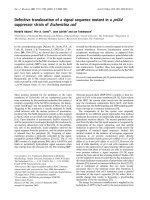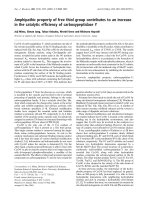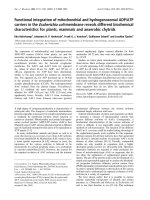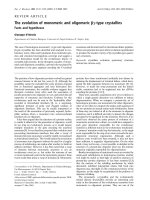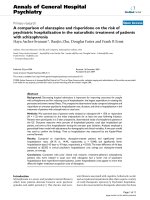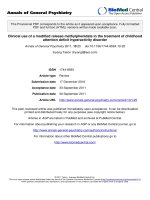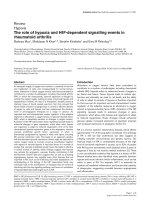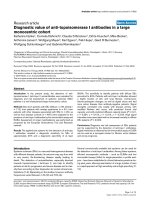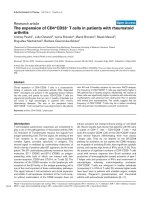Báo cáo y học: " Short-term prediction of threatening and violent behaviour in an Acute Psychiatric Intensive Care Unit based on patient and environment characteristics" pps
Bạn đang xem bản rút gọn của tài liệu. Xem và tải ngay bản đầy đủ của tài liệu tại đây (227.02 KB, 7 trang )
RESEARCH ARTIC LE Open Access
Short-term prediction of threatening and violent
behaviour in an Acute Psychiatric Intensive Care
Unit based on patient and environment
characteristics
Arne E Vaaler
1,2*
, Valentina C Iversen
1,3
, Gunnar Morken
1,3
, John C Fløvig
1,3
, Tom Palmstierna
1,4,5
, Olav M Linaker
1,2
Abstract
Background: The aims of the present study were to investigate clinically relevant patient and environment-related
predictive factors for threats and violent incidents the first three days in a PICU population based on evaluations
done at admittance.
Methods: In 2000 and 2001 all 118 consecutive patients were assessed at admittance to a Psychiatric Intensive
Care Unit (PICU). Patient-related conditions as actuarial data from present admission, global clinical evaluations by
physician at admittance and clinical nurses first day, a single rating with an observer rated scale scoring behaviours
that predict short-term violence in psychiatric inpatients (The Brøset Violence Checklist (BVC)) at admittance, and
environment-related conditions as use of segregation or not were related to the outcome measure Staff
Observation Aggression Scale-Revised (SOAS-R). A multiple logistic regression analysis with SOAS-R as outcome
variable was performed.
Results: The global clinical evaluations and the BVC were effective and more suitable than actuarial data in
predicting short-term aggression. The use of segregation reduced the number of SOAS-R incidents.
Conclusions: In a naturalistic gro up of patients in a P ICU segregation of patients lowers the number of aggressive
and threatening incidents. Prediction should be based on clinical global judgment, and instruments designed to
predict short-term aggression in psychiatric inpatients.
Trial registrations: NCT00184119/NCT00184132
Background
Threatening and violent behaviour by ps ychiatric inpati-
ents are major concerns in psychiatric practice [1,2].
Aggression has negative consequences for patients and
staff. Some studies indicate an incre asing frequency
[3,4]. Reduction of sever ity and inci dence of threatening
and violent incidents are important in order to improve
quality of care in psychiatric facilities. Prediction of vio-
lence is consequently importan t in order to initiate pre-
ventive measures. Risk factors and accuracy of
predictions in different psychiatric settings have been
extensively described [5].
In Psychiatric Intensive Care Units (PICUs) and emer-
gency services violent incidents are frequent and short-
term predictions of violence imp ortant [6]. Patients in
these settings present in severe crisis often complicated
by behavioural dyscontrol, substance use, and multiple
axis 1 diagnoses [7]. Prediction and prevention of
aggression in emergency services patients could thus
potentially be based on numerous data drawn from indi-
vidual medical and social history, treatment conditions,
behaviours and psychopathology. A history of violence
in medical records, and a diagnosis of schizophrenia or
substance abuse are known predictors for violence [5,8].
However, in the emergency setting with acute
* Correspondence:
1
Department of Neuroscience, Faculty of Medicine, Norwegian, University of
Science and Technology, Trondheim, Norway
Full list of author information is available at the end of the article
Vaaler et al. BMC Psychiatry 2011, 11:44
/>© 2011 Vaaler et al; licensee BioMed Central Ltd. This is an Open Access article distributed under the terms of the Creative Commons
Attribution License (http://creativecommo ns.org/license s/by/2.0), which permits unrestricted use, distribution, and reproduction in
any medium, pro vided the original work is properly cited.
admittances of unknown patients these factors are often
unknown and thereby clinically irrelevant. These are
indicat ions that such predictors have more limited value
in emergency clinical settings compared to community
or forensic settings [5,8-10]. In acute settings short-term
prediction may be m ore accurate based on global clini-
cal judgment [9-11], or rating scales specifically devel-
oped to assess short-term prediction of aggressive
incidents [12]. In a retrospective study from a PICU
population Bjørkdahl et al demonstrated that nurses can
predict violence to a high degree for the next 24 hours
with three times daily assessments using the Brøset Vio-
lence Checklist (BVC) [12].
Differences in methods, designs, outcome measures
and settings make it difficult to compare studies of
short-term prediction of violence. T he weaknesses in
most designs are underreporting of incidents, lack of
correction for therapeutic interventions, and a disregard
of the influence from the treatment environment [5,9].
Environment-related conditions like extent of segrega-
tion of behaviourally disturbed patients are believed to
influence rate of aggressive incidents [13].
Rating scales specifically developed to measure fre-
quency and severity of violent or threatening incidents,
a prospective research design, and control of environ-
ment-related conditions and treatment factors are
believed to minimize the problems in research methods.
The frequency of threatening and violent incidents dif-
fers with the stages of psychiatric disorders [14]. The
highest frequencies of such incidents are reported in
acute stages of in-patient hospital stay which indicate
the first few days in emergency settings.
The aims of the present prospective study were to
investigate c linically relevant patient and environment-
related predictive factors for threatening and violent
incidents the first three days in a psychiatric acute
emergency population based on evaluations at admit-
tance. These patient-related conditions are actuarial data
(age, gender, admission status and diagnosis), assess-
ments of symptoms, function and behaviour, therapeutic
interventions the first day, global clinical impression
assessed by physician on duty, global clinical impression
assessed by treating nurses, and predictive properties
from a single BVC rating at admittance; while the envir-
onment-related condition is the use of the PICU as a
segregation area or not.
Methods
Population
The psychiatric department at St. Olavs University Hos-
pital, Trondheim, Norway has a catchment area of
140.000 inhabitants. About 700 patients above 18 years
with acute psychiatric conditions are admitted each
year. Norwegian acute psychiatric emergency services
are publicly funded and available to everyone. All the
patients in the catchment area are admitted to this
department. A cute admissions to other psychiatric hos-
pitals occur only if inhabitants temporarily reside out-
side the catchment area when the need for acute
admittance arises.
Setting
The acute department consists of two ordinary closed
emergency wards each with a PICU area w ith 4 beds.
The patients were admitted to the acute ward with most
free capacity. One ward was used for the study, and the
patients excluded from the study were admitted to the
other ward.
The physician on duty evaluated all the patients
acutely admitted to the ward. Patients assessed to be in
need of PICU were admitted to the PICU area and
included in the study except those with dementia, men-
tal retardation or autism to a severe degree, and patients
not speaking Norwegian or English. They were excluded
at evaluation before entering the PICU area and
admitted to the other ward.
The study ward consists of an ordinary closed acute
ward area (310 m
2
)andaPICUarea(190m
2
). The main
entrance leads to the ordinary area of the ward. In the
end of the corridor a locked door separates the PICU
area from the ordinary area. The PICU area consists o f
two wings with two single patient rooms in each. The
patients stay mostly in the wings together with nurses,
and contact with other patients is limited. The PICU are a
thus provides segregation from other persons. A sketch
of the ward is published previously [15].
Data from the present study stems from two different
inclusion periods in the PICU with background data
published previously [15,16].Thetwosampleswere
comparable for all measurements at inclusion [15]. In
the first inclusion period the entrance door to the PICU
area was permanently locked and the doors inside the
PICU leading to the wings were kept permanently
closed (inclusion1). In the second period the entrance
door to the PICU area was removed and the doors
inside the PICU were permanently open (inclusion 2).
These two conditions made it possible to compare two
different methods of organizing a PICU [15]. Inclusion 1
was a completely segregated PICU-condition, while
inclusion 2 was a condi tion giving the patients opportu-
nity to choose between a certain level of isolation and
calmness by staying in the patient room/wing of the
PICU or move to the main part of the ward ensuing
exposure to other patients, more staff-members and
increased amounts of sensory and emotional stimuli.
The clinical staffs were similar in these inclusion peri-
ods. There was no significant difference in occupation
of PICU-beds between inclusion 1 and 2.
Vaaler et al. BMC Psychiatry 2011, 11:44
/>Page 2 of 7
The environment-related condition in the inclusions
thus was the use of the PICU as a segregation area or
not [15]. The difference between the inclusions as a pos-
sibl e predictive factor for SOAS-R incident s is the para-
meter “Segregation”.
Instruments
Symptoms, general psychopathology, function and beha-
viour were assessed with a single rating on the first day in
the PICU with the Positive and Negative Syndrome Scale
(PANSS) for schizophrenia [17] with time criterion the
last 24 hours, the Global Assessment Scale Split version
(GAF-S), and the Brøset Violence Checklist (BVC) [18].
GAF-S is b ased on DSM-4’sGAF[19]andisatwo-item
scale measuring global symptoms (GAF-S-Symptoms) and
functioning (GAF-S-Function) separately. BVC is a six-
item observer-rated scale scoring behaviours that predicts
immi nent violence in psychiatric inpatients [20,21]. BVC
predictions are traditionally performed three times daily
[20,21] as opposed to the present study evaluating predic-
tive properties for the next three days from a single assess-
ment at admittance. Since psychometric properties of The
PANS S used in an emergency setting with time criterion
last 24 hours is not previously tested, two trained ward
nurses evaluated this in a separate pre-study. Through
scorings of 3 video-taped patient interviews [22] and
assessments of 12 consecutively admitted acute emergency
patients, the ward nurses demonstrated excellent inter-
rater reliability for total PANSS sum, sums of positive
(Pearson’s r = 0.96), negative (r = 0.84) and general sub-
scales (r = 0.87), as well as the 30 single items.
Violent or t hreatening incidents were recorded with
the Staff Observation Scale-Revised (SOAS-R) [23,24].
The SOAS-R severity score ranges from 0-22 points
with higher scores indicating g reater severity [25]. A
SOAS-R score ≥ 9 indicates a serious incident [12,24].
Therapeutic- and control steps taken and nurses’
observations were coded on a 23-item checklist. These
therapeutic steps and observations included for instance
“frequ enc y of testing out and pushing limits” , “intensity
of testing out and pushing limits”, “need to set limits”,
all prescribed medication, side effects, formal restrictions
(restrictions regarding visits and telephone), staff contact
time, use of newspapers, and visits from relatives.
Depending on the type of item each were scored on
scales0-4(0=notpresent,4=verymuch)or0-1(0=
not used, 1 = used). Specially trained unit nurses did all
the ratings. The first rating with the items “frequency of
testing out and pushing limi ts”, “intensity of testing out
and pushing limits”, and “need to set limits” was used as
a possible predictor after an initial, short observation of
the patient’s behaviour at admittance and right after
entrance to the PICU in order to evaluate whether the
experienced staff’ s assessments of the patients’
immediate behaviour could predict SOAS-R incidents
for the rest of the study period.
At admittance the physicianondutyevaluatedthe
patients’ need for PICU o n a scale with scorings 1-4 (1
representing no need to 4 representing absolute need).
Four categories of reason s for admittance to PICU were
noted (1: Patient’s own wish, 2: Need of close observa-
tion from diagnostic or medical reasons, 3: Reduction of
stimuli, or 4: Control of behaviour). If more than one
reason was present, the physician indicated the dominat-
ing category. “Physician’s prediction” is an index defined
by giving the patients with category 4 reason for admit-
tance the scorings on “patients’ need” of PICU, and the
rest of the patients value 0. “ Physicians prediction”
therefore has scorings 0-4 with increasing value indicat-
ing increasing assumed probability for violent or threa-
tening incidents.
The patients were systematically examined for sub-
stance use at admittance, at evaluation with ward psy-
chiatrist the first weekday after admittance, and at
dischargefromPICU.Inthefirstperiod(November13
2000 to March 25 2001) (n = 56), urine samples we re
analysed on clinical suspicion of substance use. In the
second period (October 1 2001 to March 21 2002) (n =
62), a ll admitted patients had urine- and blood samples
taken within a few hours after admission.
Diagnoses according to ICD-10 Diagnostic criteria for
research [26] were se t by consensus in the department’
s
staff,
including at least three specialists in psychiatry of
whom at least two personally had examined the patient.
Statistical Analyses
All data were analysed using the Statistical Package for the
Social Sciences (version 11.0). Demographic and clinical
variables were described using means an d frequencies.
Independent t-tests were used to compare differences
between groups. Multiple logistic regression forced-entries
were performed to examine the extent of the predictor
variables’ associations with SOAS-R incidents. The vari-
able SOAS-R was categorised as incidents and non-inci-
dents. Relative risk (RR) was calculated with Fischer’ s
exact test and a generalized mixed model with Poisson dis-
tribution of SOAS-R incidents. The missing values were
replaced with the mean score for each item. Statistical sig-
nificance was defined as a two-tailed p < 0.05.
Ethics
The study was approved by “The Regional Medical
Research Ethics Committee, Central Norway.”
Results
Characteristics of the sample
In the two inclusion periods 56 and 62 patients were
included. Mean length of stay in the PICU was 5.6 days
Vaaler et al. BMC Psychiatry 2011, 11:44
/>Page 3 of 7
(SD 0.6). One patient was excluded due to senile
dementia. The number of males/females was 66/52 with
mean age 36.3 years (SD 14.7). Fift y-seven (48.3 %) were
involuntarily admitted. Thenumberofpatientsineach
category of reasons for admittance to PICU were:
Patient’s own wish 3 (2.5%); Need of close observation
from diagnostic or medical reasons 51 (43.2%); Reduc-
tion of stimuli 23 (19.5%); and Control of behaviour 40
(33.9%). The patients admitted to PICU due to “control
of behaviour” had a mean need for stay = 3 (3; indicat-
ing probable need for segregation and 4; absolute need
for segregation). The first three days a total of 3 (inclu-
sion 1) (the PICU-condition with complete segregation)
and 19 (inclusion 2) (the PICU-condition without com-
plete segregation) (RR 5.72, p < 0.01(Poisson distribu-
tion), 95% CI: 1.69-19.33) violent or threatening
incidents were recorded among 3 (inclusion 1) (com-
plete segregation) and 10 (inclusion 2) patients (11%)
(RR 3.01, ns (p = 0.08) (Fischer’ s exact test), 95% CI:
0.81-20.10). The effect for segregation indicates that
patients who were not segregated were 3.0 times more
likely to engage in a violent incident than those who
were segregated.
The mean SOAS-R severity score for these incidents
was 10.1 (SD 14.7). The distribution of scores of SOAS-
R -incidents and no SOAS-R-incidents, were found to
have a mean of 0.11 (SD = .031 ). The number of serious
incidents defined as SOAS-R severity score ≥ 9 was 16.
The incidents with severity scores <9 were all verbal
threats directed towards staff. Mechanical restraints
(belts) were used twice in each inclusion period.
The main diagnoses were F 00-09 (organic mental dis-
orders) 6, F 10-19 (substance abuse) 24, F 20-29 (schizo-
phrenia) 45, F 30-39 (mood disorders) 22 and F 40+
(other mental disorders) 21. Nine patients (coded F 20-
29)fulfilledcriteriaforbothschizophreniaandsub-
stance abuse diagnoses. The prevalence of differ ent sub-
stances used by the patients in the present depart ment
is published previously [27].
Selection of variables for analyses
Due to the limitations in the number of variables in the
multiple regression analysis, the in dividual variables o f
possible interest were analysed for possible contribution
to SOAS-R incidents with chi square tests for categori-
cal and Student’ s T-tests for continuous data. PANSS
total, PANSS subscales, GAF-S, medication, side effect s,
“frequ enc y of testing out and pushing limits” , “intensity
of testing out and pushing limits”, “need to set limits”,
gender and age did not contribute significantly. The
items BVC, “Segregation” and “ Physicians prediction”
items were selected for subsequent multiple logistic
regression forced-entry analyses (Table 1). A further
analysis was carried out to examine the items that
predicte d SOAS-R incidents. Diagnoses of schizophrenia
and substance abuse were used as independent variables
since earlier studies have shown that aggressiveness has
been related to schizophrenia and substance abuse
[28-30]. The proportions of patients with these diag-
noses were 36.4% and 38.1% respectively.
A multiple logistic regression forced-entry analysis was
performed on SOAS-R as outcome variable and the five
predictors: BVC, “Physicians prediction”, “Segregation”,
and diagnosis of schizophrenia or substance abuse. The
results are given in Table 2. The size of R
2
(58%) indi-
cates that the model contributes powerfully to the pre-
diction of the SOAS-R incidents or non-incidents. The
variables BVC, “Physicians prediction”,and“ Segrega-
tion” contribute significantly to predict SOAS-R inci-
dents. The equation did not find statistically significant
associations between SOAS-R (incidents or non-inci-
dents) and a diagnosis of schizophrenia or substance
abuse. The Hosmer-Lemeshow test was non-significant
indicating that the fit of the model was good (p = 0.55).
Table 1 Comparison of patients with SOAS incidents (n =
13) and without SOAS Incidents (n = 105).
SOAS
incidents
Mean/SD
Non-SOAS
incidents
Mean/SD
Statistical
significance
Total PANSS
a
85.5(25.3) 72.4(21.4) NS
GAF-S
b
24.5(12.6) 32.6(12.9) NS
GAF-F
b
23.4(9.3) 33.8(12.4) NS
BVC
g
2.54(1.9) .60(.87) P = .002
Side effects NS
Extrapyramidal .00 (.00) .02(.19)
Acathisia .00(.00) .05(.29)
Frequency of testing out
and pushing limits
1.46(1.12) .50(.92) NS
Need to set limits 1.54(1.05) .53(1.97) NS
Intensity of testing out and
pushing limits
1.92((1.55) .50(.98) NS
Segregation 1.77(.43) 1.50(.50) P = .041
Diagnosis of schizophrenia .46(.51) .37(.48) NS
Diagnosis of substance
abuse
.07(.27) .21(.41) NS
Physician’s prediction 3.85(.55) 2.70(.29) P = .039
Medication NS
Hypnotics and
sedatives
.31(.48) .37(.48)
Anti-depressive .08(.27) .18(.38)
Anti-epileptic .00(.00) .16(.37)
Neuroleptic .38(.50) .31(.46)
SD = standard deviation. NS = not significant. Significance level p ≤ 0.05.
a
The Positive and Negative Syndrome Scale for schizophrenia. Scoring range
30-210.
b
The Global Assessment of Functioning Scale - Split version. Scoring range 1-
100.
g
The Brøset Violence Checklist. Scoring range 0-6.
Vaaler et al. BMC Psychiatry 2011, 11:44
/>Page 4 of 7
Discussion
The present study gives evidence for a positive effect of
segregation quantitatively determined in relation to
other variables. We are not aware of the presence of
such evidence so far. This finding is highly r elevant for
both clinical practice and the design of psychiatric
wards. Effects of ward space and architecture are spar-
sely studied. Palmstierna et al found that patients with
schizophreniaweremorelikelytobeaggressiveina
crowded ward [31]. In a second study the same authors
did not find a decline in the frequency of aggression in
spite of a reduction of the number of beds by 50% [32].
Nijman et al we re unable to document a decline i n
aggressive incidents after extending space in a ward
[33]. In the present study the number of beds and the
spacewereidenticalinthetwoinclusions[15].This
finding indicates that an important factor in reducing
aggressive incidents is the separation of single patients
or patient groups in the ward, not the physical space in
terms of square meters per patient.
Our data predicting short-term violent and aggressive
incidents in a PICU are in accordance with previous stu-
dies from acute wards. Generally the predictive values
from actuarial data are limited. The global clinical eva-
luation “Physicians prediction” from physician on d uty,
and the observer-rated scale scoring behaviours predict-
ing imminent violence in psychiatric inpatients (BVC),
were more suitable for predicting short-term violent and
threatening incidents in the PICU setting . Since BVC is
based on observer rated scorings of behaviour, the pre-
sent study demonstrates that experienc ed staff members
in acute settings are able to globally predict short-term
violence in their patient populations.
We found no association between SOAS-R ratings and
psychopathology measured by PANSS total, PANSS sub-
scales, and GAF-S. This finding is similar to Swett et
al’s [34]. Steinert et a l. in contr ast found that scor ings
on the seven-item PANSS-po sitive scale correlated sig-
nificantly with the number of threatening or aggressive
incidents in a sample of acutely admitted in-patients
[35]. Findings from studies using the Brief Psychiatric
Rating Scale (BPRS) [36] or PANSS are contradictory.
Using t he full scale PANSS is time consuming, but this
systematic questioning discloses important aspects of
symptoms and makes the staff able to take these into
account in therapy. This may lowe r the number of vio-
lent or threatening incidents, an d make conclusions
from different studies difficult [16].
The observer rated instrument BVC is based on
reports of the most frequent behaviours observed prior
to violent incidents, and it assesses the presence or
absence of the six behaviou ral states confusion, irritabil-
ity, boisterous behaviour, verbal threatening, physical
threatening, and attacking objects [20]. It has demon-
strated satisfactory properties in forensic and acute set-
tings [21,37], and now in a PICU setting. The
instrument is short, practical and easy to administer in
routine care. Systematic uses of standardis ed instru-
ments like BVC give staff opportunities to focus on pre-
ventive measures towards limited numbers of high-risk
patients.
Involuntary admission status did not predict SOAS-R
incidents in the present study. This finding is contrary
to Nijman et al.’ s who found a history of involuntary
admission to be a predictor of aggressive behaviour [10].
This may partly be due to different criteria for involun-
tary admissions. Some co untries (e.g. Dutch law [10])
allow for ced hospitalisation only when a patient’sbeha-
viour constitutes a direct and clear danger to the patient
or others. Norwegian law extends this concept to allow
involuntary admissions in other cases of severe mental
illness based on the need of treatment.
Diagnoses of substance use or schizophrenia are
reported to be predictive factors for aggressive incidents
[5,28-30]. This was not supported by the present data.
Assessment of substance use is difficult and under-
reporting is a problem. In the present study substance
abuse was extensively assessed. Our study indicates that
presence of substance use diagnoses do not facilitate
threatening and violent behaviour among patients in a
PICU setting [38].
Several studies with different interventions have been
conducted to assess the effects of preventive measures
on aggressive incidents [39]. Conclusions are difficult to
draw due to shortcomings in the research designs like
lack of control conditions, possible under-reporting of
aggressive incidents and staffs ’ awareness of th eir wards
being objects of research. There are also indications that
systematic monitoring of aggressive incidents with for
instance SOAS-R, increases the staffs’ awareness of risk
factors eventually leading to a decrease in numbers of
incidents. Nijman et al [39] compared the effects of sev-
era l possible aggressive incidents reducing interventions
in a closed psychiatric admission ward with two similar
control wards. The main results were a significant
Table 2 Multiple logistic regression predicting SOAS-R
incidents.
Predictors 95% CI for exp b
B (SE) Lower Exp b Upper
BVC 1.07** 1.42 2.91 5.91
“Segregation” 2.23* 1.32 9.37 66.31
Physicians prediction 1.66* 1.20 5.28 23.16
Diagnosis of substance abuse -1.59 0.033 0.03 1.26
Diagnosis of schizophrenia 0.26 0.24 1.29 6.51
Note: R
2
= .57 (Hosmer&Lemeshow), .29 (Cox & Snell R.), .58 (Negelkerke R.)
Model X
2
(5) = 40.10 *p < 0.05, **p < 0.01
Vaaler et al. BMC Psychiatry 2011, 11:44
/>Page 5 of 7
reduction of aggressive incidents in all the three wards.
The reducti on in the intervent ion ward and cont rol
wards were 62% and 43%, a differe nce that turned out
to be non-significant. The present study indicates that
global experience in staff and structured in struments
may help identify patients where preventive measures
should be considered. These measures should i nclude
physical separation of these high-risk patients from the
others.
This study has weaknesses. “Physicians prediction” is
an index composed of the physician on d uty’s global
impression of the patients need and reason for admit-
tance to PICU. This is not a validated instrument, but
reflects the main outcome of what goes on in the mind
of the experienced clinician. T he nurse-rated 23-item
checklist “ Therapeutic- and control steps taken and
nurses’ observations” has similar shortcomings. The
SOAS-R incidents are few, but comparable to other stu-
dies. The mean severity score of the incidents is
moderate.
The study sample is a consecutive, highly-selected
sample of acutely admitted patients assessed in a PICU.
The methods and facilities used for emergency psychia-
try differ between countries [40]. This special PICU
have similarities to what Bowers names “ open area
seclusion” [40]. Different selections in different facilities
may give other results. However, the principles of stimu-
lus reduction and segregat ion from other patients are
similar to other segregation settings. This may indicate
that our study generally illustrates the effects seen also
in traditional seclusion settings.
Segregation of patients raises ethical and legal ques-
tions. During the last years there have emerged new leg-
islations, recommendations, court cases and professional
guidelines to control the use of coercive measures in
psychiatry. The recurring message in all of these guide-
lines is the need to practice caution when applying seg-
regation in the form of seclusion [41]. The present
segregation setting represents an effective alternative to
seclusion with the patients staying mostly in the wings
together with nurses [15].
The strengths of the study are numerous. First of all
this is a prospective design in a naturalistic patient
population from a defined catchment area. We have
used robust validated instruments assessing symptoms,
general psy chop athology, function, behaviours and end-
point measure. The routine screening for substance
abuse was comprehensive. Therapeutic and control
steps taken the first day were assessed. The degree of
potential under-reporting of aggressive or threatening
incidents is l imited due to the prospective design and
daily prompting for registrations. Finally the influence of
the physical environment is incorporated in evaluation.
Conclusions
In the psychiatric emergency setting the procedure of
segregation of single patients predicts lowered numbers
of short-term aggres sive incidents. Predictions at admit-
tance should further be based on a global cli nical eva-
luation from the physician a t admittance, or rating with
instruments designed to predict short-term ag gression
in psychiatric in-patients like the Brøset Violence
Checklist.
Acknowledgements
The study was funded from the Norwegian University of Science and
Technology and St Olavs University Hospital. The authors thank Berit Hansen
and Gaute Strand for conducting the inter-rater pre studies.
Author details
1
Department of Neuroscience, Faculty of Medicine, Norwegian, University of
Science and Technology, Trondheim, Norway.
2
Division of Psychiatry,
Department of Research and Development, St Olavs University Hospital,
Trondheim, Norway.
3
Division of Psychiatry, Department Østmarka, St Olavs
University Hospital, Trondheim, Norway.
4
Social and Forensic Psychiatry
Program, Stockholm Centre for Psychiatric Research and Education,
Karolinska Institutet/Stockholm County Council Health Care Provision,
Stockholm, Sweden.
5
St. Olav’s University Hospital, Forensic Dept. and
Research Centre Brøset, Trondheim, Norway.
Authors’ contributions
AEV, VCI, GM, JCF and OML conceived and designed the study. VCI and AEV
coordinated the study including the inclusion of patients. TP analyzed and
interpreted the data. All authors helped to draft the manuscript, and all
authors read and approved the final version.
Competing interests
The authors declare that they have no competing interests.
Received: 22 August 2010 Accepted: 18 March 2011
Published: 18 March 2011
References
1. Lehmann LS, McCormick RA, Kizer KW: A survey of assaultive behaviour in
Veterans Health Administration facilities. Psychiatr Serv 1999, 50:384-389.
2. Soliman AE-D, Reza H: Risk factors and correlates of violence among
acutely ill adult psychiatric inpatients. Psychiatr Serv 2001, 52:75-80.
3. James DV, Fineberg NA, Shah AK, Priest RG: An increase in violence on an
acute psychiatric ward: a study of associated factors. Br J Psychiatry 1990,
156:846-852.
4. Eronen M, Angermeyer MC, Schulze B: The psychiatric epidemiology of
violent behavior. Soc Psychiatry Psychiatr Epidemiol 1998, 33:13-23.
5. Steinert T: Prediction of inpatient violence. Acta Psychiatr Scand Suppl
2003, 106:133-141.
6. Walker Z, Seifert R: Violent incidents in a Psychiatric Intensive Care Unit.
Br J Psychiatry 1994, 164:826-828.
7. Zealberg JJ, Brady KT: Substance abuse and emergency psychiatry.
Psychiatr Clin North Am 1999, 22:803-816.
8. Palmstierna T, Wistedt B: Risk factors for aggressive behaviour are of
limited value in predicting the violent behaviour of acute involuntarily
admitted patients. Acta Psychiatr Scand 1989, 81:152-155.
9. Apperson LJ, Mulvey EP, Lidz CW: Short-term clinical prediction of
assultive behavior: Artifacts of research methods. Am J Psychiatry 1993,
150:1374-1379.
10. Nijman H, Merckelbach H, Evers C, Palmstierna T, à Campo J: Prediction of
aggression on a locked psychiatric admission ward. Acta Psychiatr Scand
2002, 105:390-395.
11. McNiel DE, Binder RL: Correlates of accuracy in the assessment of
psychiatric inpatients’ risk of violence. Am J Psychiatry 1995, 152:901-906.
Vaaler et al. BMC Psychiatry 2011, 11:44
/>Page 6 of 7
12. Bjørkdahl A, Olsson D, Palmstierna T: Nurses’ short-term prediction of
violence in acute psychiatric intensive care. Acta Psychiatr Scand 2006,
113:224-229.
13. Hodgkinson P: The use of seclusion. Med Sci Law 1985, 25:215-222.
14. Davis S: Violence by psychiatric inpatients. A review. Hosp Community
Psychiatry 1991, 42:585-590.
15. Vaaler AE, Morken G, Fløvig JC, Iversen VC, Linaker OM: Effects of a
Psychiatric Intensive Care Unit in an acute psychiatric department. Nord
J Psychiatry 2006, 28:65-70.
16. Vaaler AE, Morken G, Linaker OM: Effects of different interior decorations
in the seclusion area of a psychiatric acute ward. Nord J Psychiatry 2005,
59:19-24.
17. Kay SR, Fiszbein A, Opler LA: The Positive and Negative Syndrome Scale
(PANSS) for schizophrenia. Schizophr Bull 1987, 13:261-276.
18. Almvik R, Woods P: Predicting inpatient violence using the Broset
Violence Checklist (BVC). Int J Psychiatr Nurs Res 1999, 4:489-497.
19. American Psychiatric Association: Global Assessment of Functioning (GAF)
scale. Diagnostic and Statistical Manual of Mental Disorders. 4 edition.
Washington DC: APA; 1994.
20. Linaker OM, Busch-Iversen H: Predictors of imminent violence in
psychiatric inpatients. Acta Psychiatr Scand 1995, 92:250-254.
21. Abderhalden C, Needham I, Dassen T, Halfens R, Haug HJ, Fischer J:
Predicting inpatient violence using an extended version of the Brøset-
Violence-Checklist: instrument development and clinical application.
BMC Psychiatry 2006, 6:17.
22. PANSS Training Videotape. Janssen Research Foundation, Richard C.
Meibach, CNS Department; 1989.
23. Palmstierna T, Wistedt B: Staff Observation Aggression Scale, SOAS:
presentation and evaluation. Acta Psychiatr Scand 1987, 76:657-663.
24. Nijman H, Palmstierna T, Almvik R, Stolker JJ: Fifteen years of research with
the Staff Observation Aggression Scale: a review. Acta Psychiatr Scand
2005, 111:12-21.
25. Nijman H, Muris P, Merchelbach H, Palmstierna T, Wistedt B, Vos AM, van
Rixel A, Allertz W: The Staff Observation Aggression Scale - Revised
(SOAS-R). Aggr Behav 1999, 25:197-209.
26. World Health Organisation: The ICD-10 classification of mental and
behavioural disorders. Diagnostic criteria for research Geneva: WHO; 1993.
27. Fløvig JC, Vaaler AE, Morken G:
Substance use at admission to an acute
psychiatric department. Nord J Psychiatry 2009, 63(2):113-119.
28. Myers KM, Dunner DL: Self and other directed violence on a closed acute
care ward. Psychiatr Q 1984, 56:178-188.
29. Angermeyer M: Schizophrenia and violence. Acta Psychiatr Scand Suppl
2000, 102:63-67.
30. Noble P, Rodger S: Violence by psychiatric inpatients. Br J Psychiatry 1989,
155:384-390.
31. Palmstierna T, Huitfeldt B, Wistedt B: The relationship of crowding and
aggressive behavior on a psychiatric intensive care unit. Hosp Community
Psychiatry 1991, 42:1237-1240.
32. Palmstierna T, Wistedt B: Changes in the pattern of aggressive behaviour
among inpatients with changed ward organization. Acta Psychiatr Scand
1995, 91:32-25.
33. Nijman HLI, Rector G: Crowding and aggression on inpatient psychiatric
wards. Psychiatr Serv 1999, 50:830-831.
34. Swett C, Mills T: Use of the NOSIE to predict assaults among acute
psychiatric patients. Psychiatr Serv 1997, 48:1177-1180.
35. Steinert T, Wølfle M, Gebhardt R-P: Measurement of violence during in-
patient treatment and association with psychopathology. Acta Psychiatr
Scand 2000, 102:107-112.
36. Overall J, Gorham DR: The brief psychiatric rating scale. Psychol Rep 1962,
10:799-812.
37. Almvik R, Woods P, Rasmussen K: The Broset Violence Checklist:
sensitivity, specificity and interrater reliability. J Interpers Violence 2000,
15:1284-1296.
38. Vaaler AE, Morken G, Fløvig JC, Iversen VC, Linaker OM: Substance abuse
and recovery in a Psychiatric Intensive Care Unit. Gen Hosp Psychiatry
2006, 28:65-70.
39. Nijman HLI, Merckelbach HI, Allertz WF, a Campo JM: Prevention of
aggressive incidents on a closed psychiatric ward. Psychiatr Serv 1997,
48:695-698.
40. Bowers L, Alexander J, Simpson A, Ryan C, Carr-Walker P: Cultures of
psychiatry and the professional socialization process: the case of
containment methods for disturbed patients. Nurse Educ Today 2004,
24:435-442.
41. Sailas EA, Wahlbeck K: Restraint and seclusion in psychiatric inpatient
wards. Curr Opin Psychiatry
2005, 18:555-559.
Pre-publication history
The pre-publication history for this paper can be accessed here:
/>doi:10.1186/1471-244X-11-44
Cite this article as: Vaaler et al.: Short-term prediction of threatening
and violent behaviour in an Acute Psychiatric Intensive Care Unit based
on patient and environment characteristics. BMC Psychiatry 2011 11:44.
Submit your next manuscript to BioMed Central
and take full advantage of:
• Convenient online submission
• Thorough peer review
• No space constraints or color figure charges
• Immediate publication on acceptance
• Inclusion in PubMed, CAS, Scopus and Google Scholar
• Research which is freely available for redistribution
Submit your manuscript at
www.biomedcentral.com/submit
Vaaler et al. BMC Psychiatry 2011, 11:44
/>Page 7 of 7
